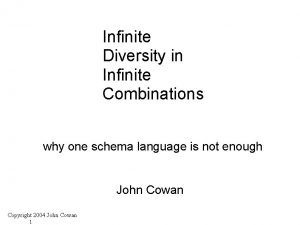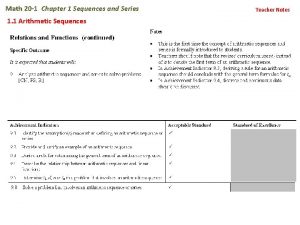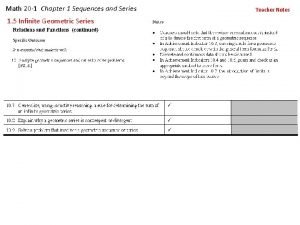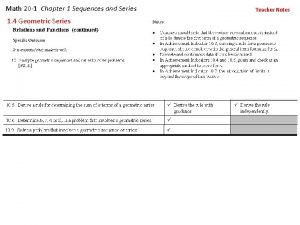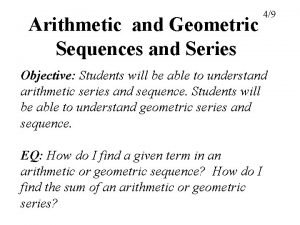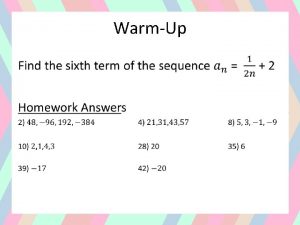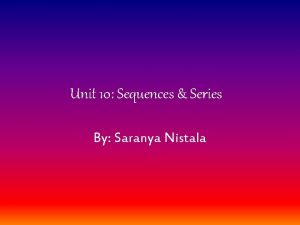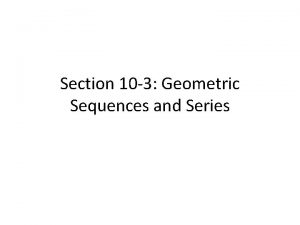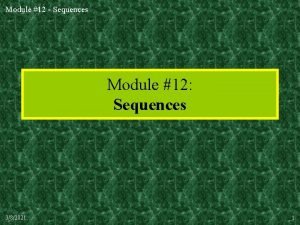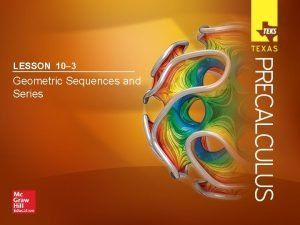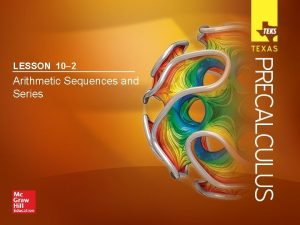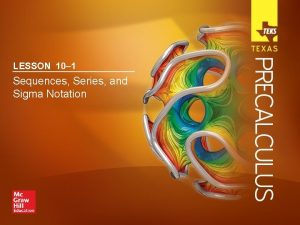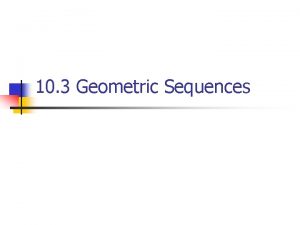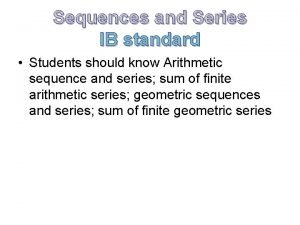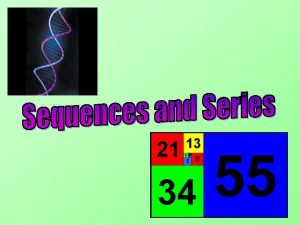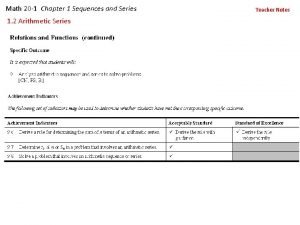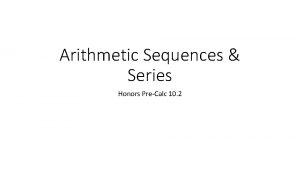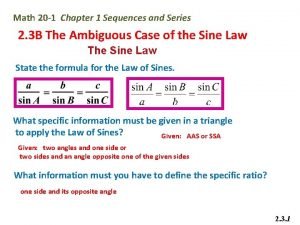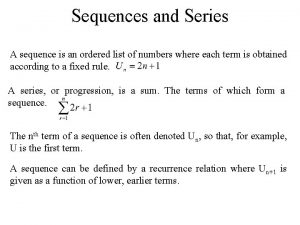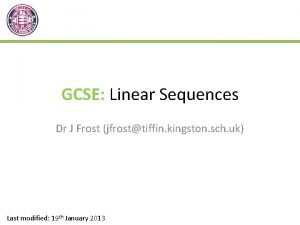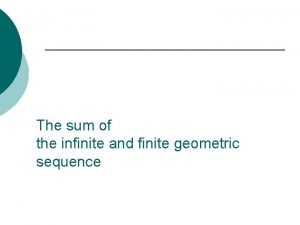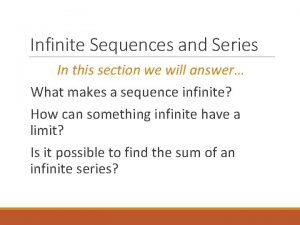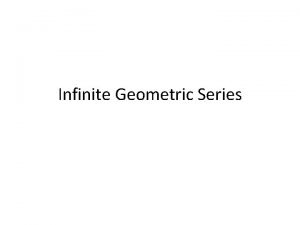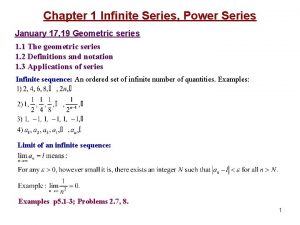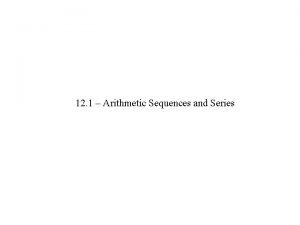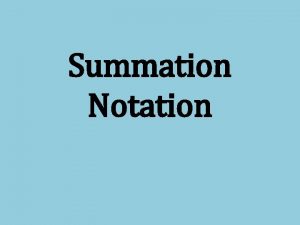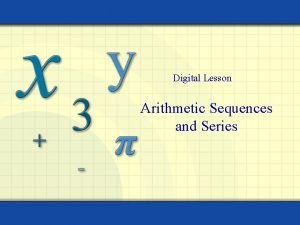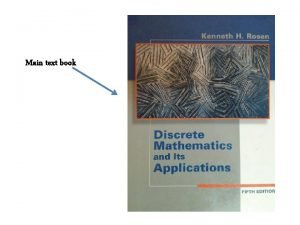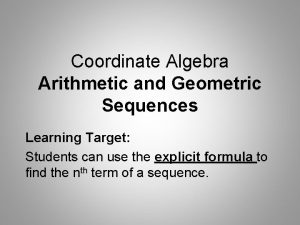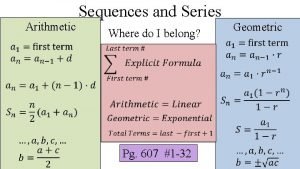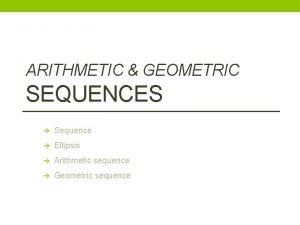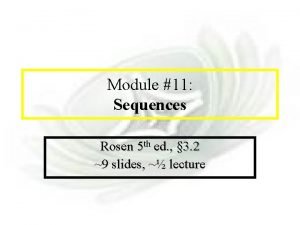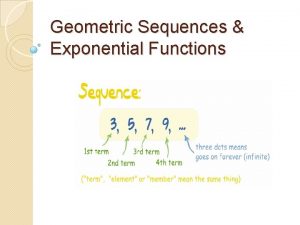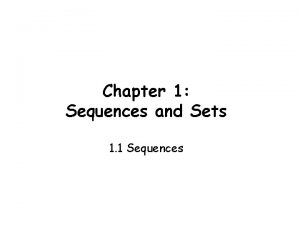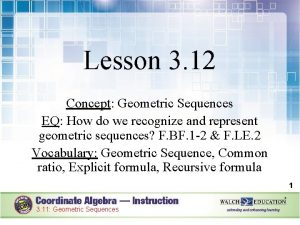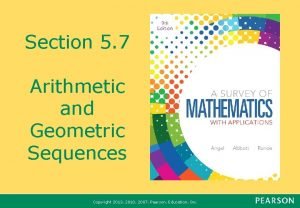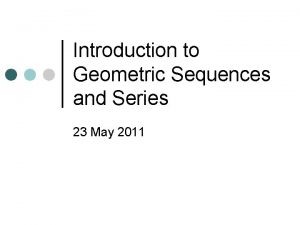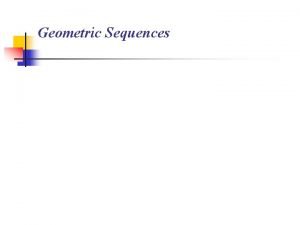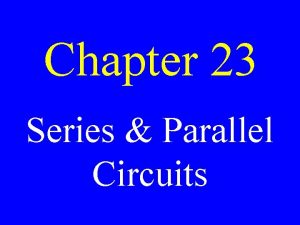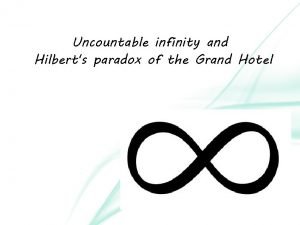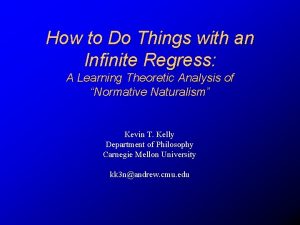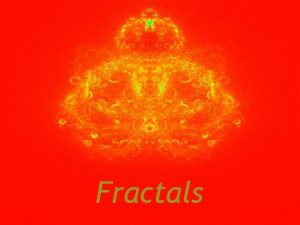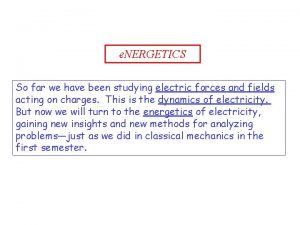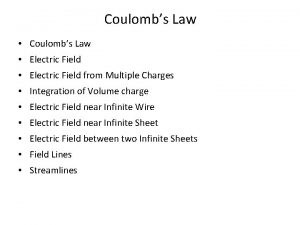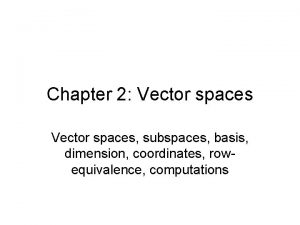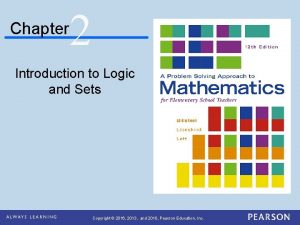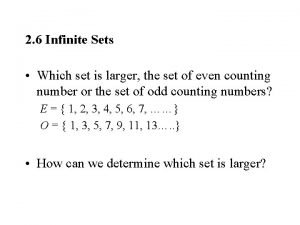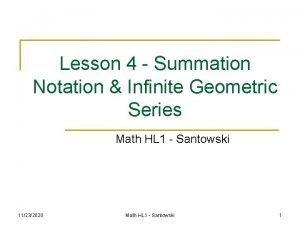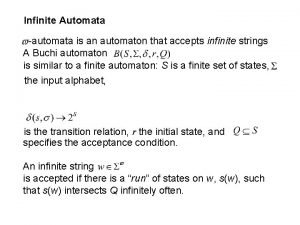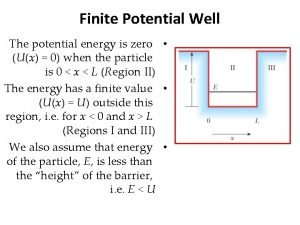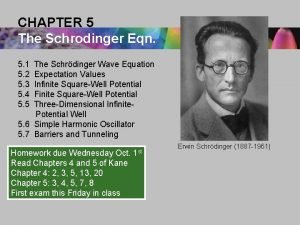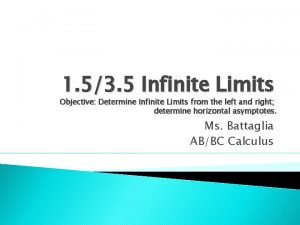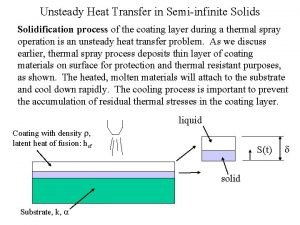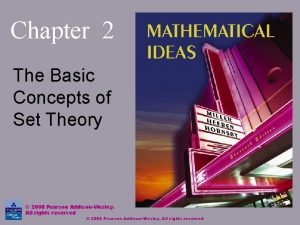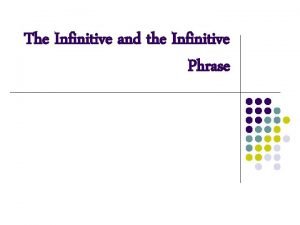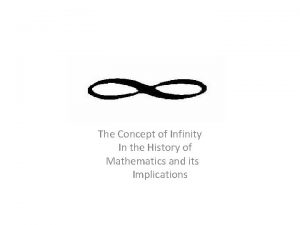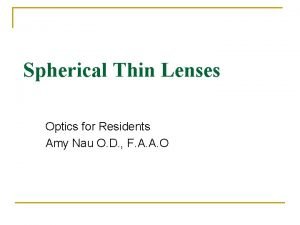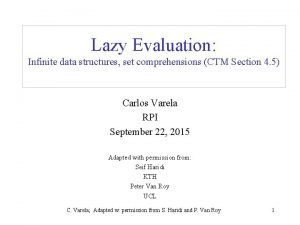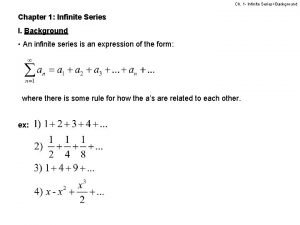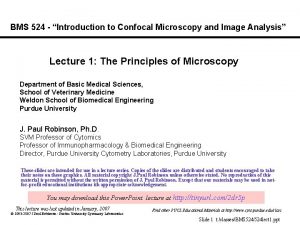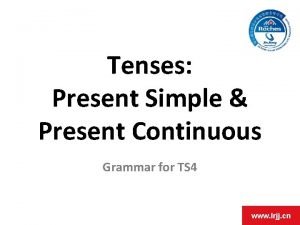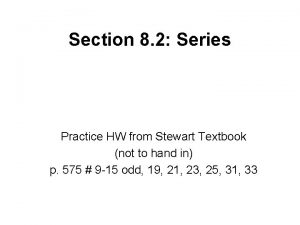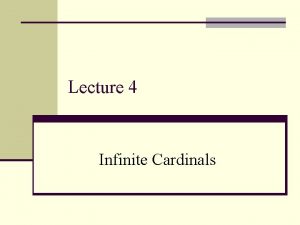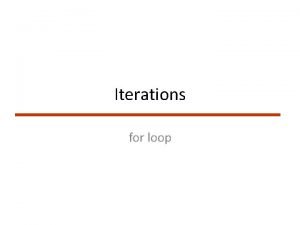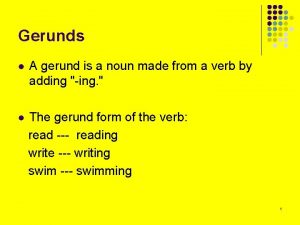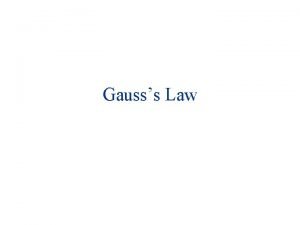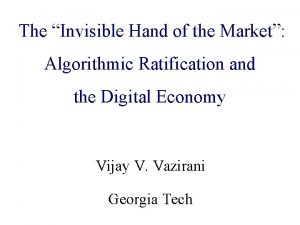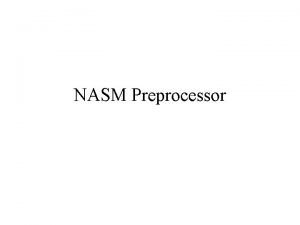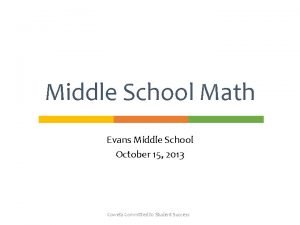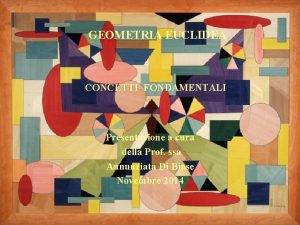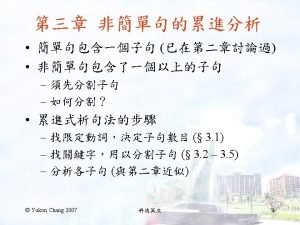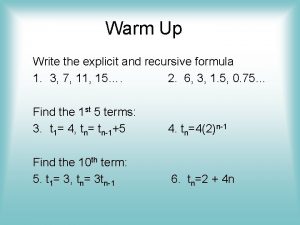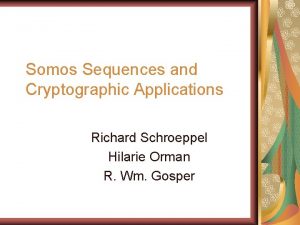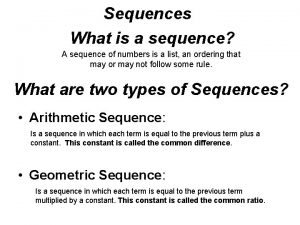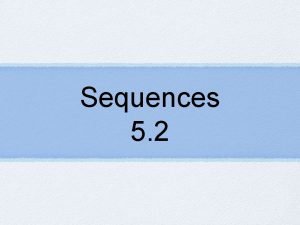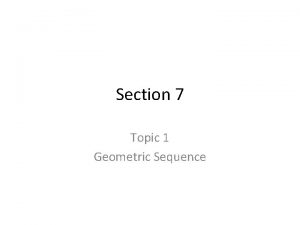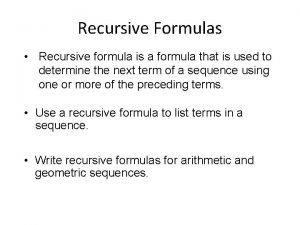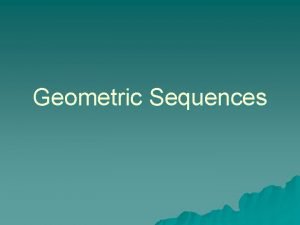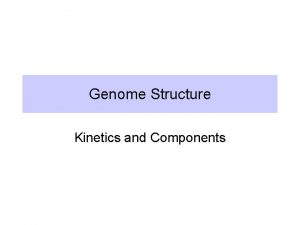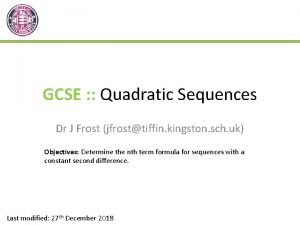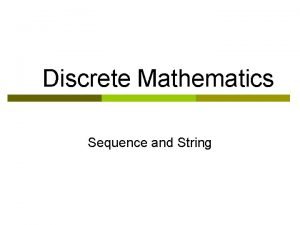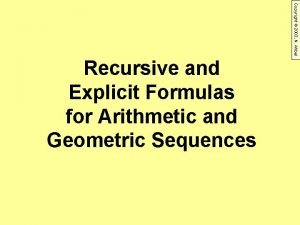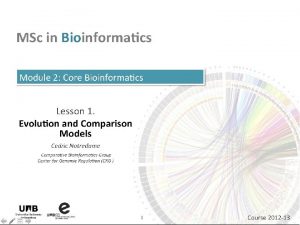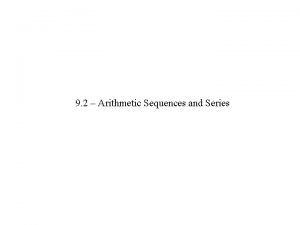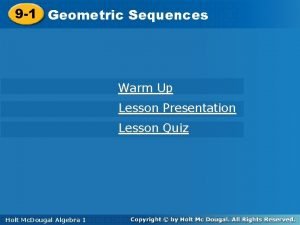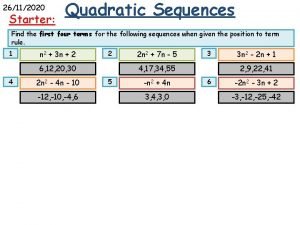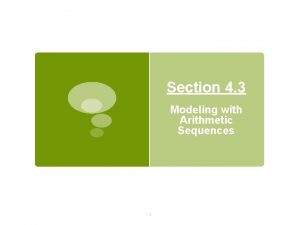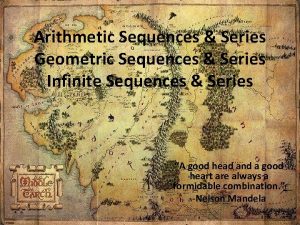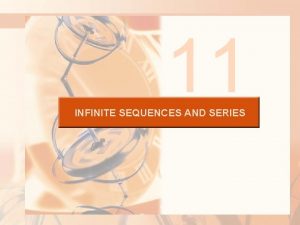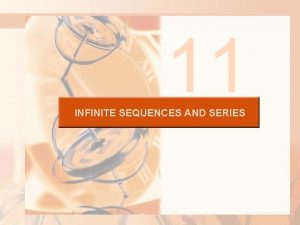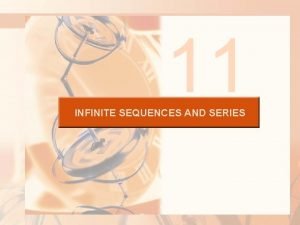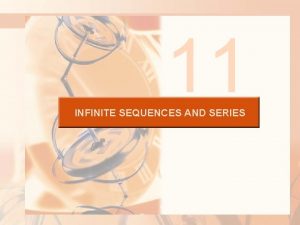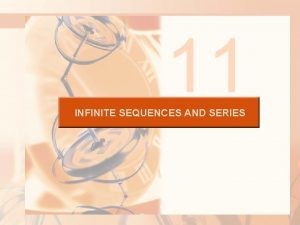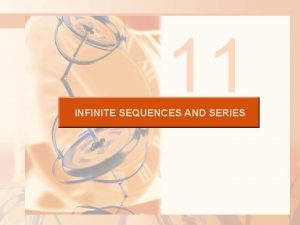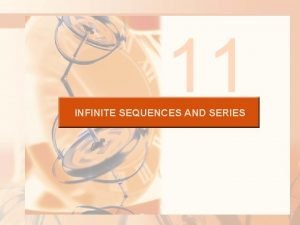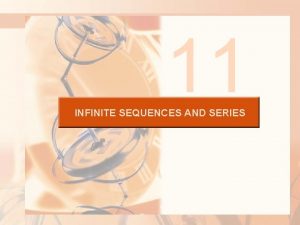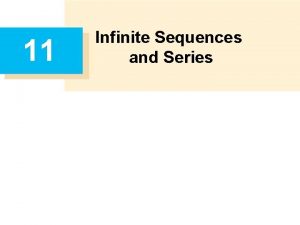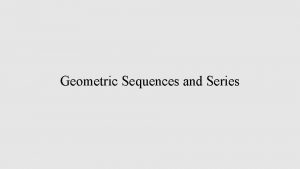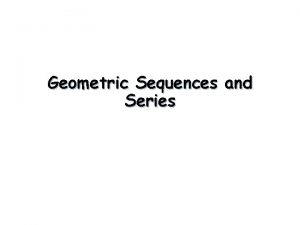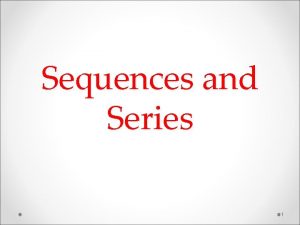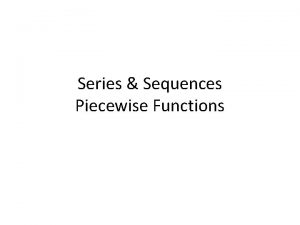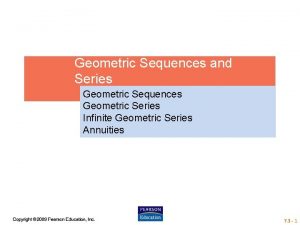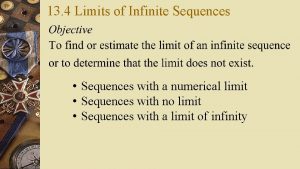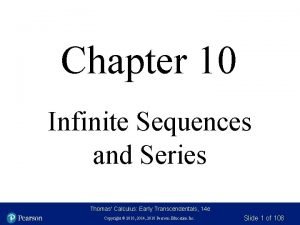Chapter 11 Infinite Sequences and Series 1 11



































































































































![y A function f(x) defined on [0, 2 p] can be represented by a y A function f(x) defined on [0, 2 p] can be represented by a](https://slidetodoc.com/presentation_image/682654a65b0af4be152ebb9de61eb212/image-132.jpg)











![Fourier series representation of a function defined on the general interval [a, b] n Fourier series representation of a function defined on the general interval [a, b] n](https://slidetodoc.com/presentation_image/682654a65b0af4be152ebb9de61eb212/image-144.jpg)
![Fourier series representation of a function defined on the general interval [a, b] n Fourier series representation of a function defined on the general interval [a, b] n](https://slidetodoc.com/presentation_image/682654a65b0af4be152ebb9de61eb212/image-145.jpg)





- Slides: 150

Chapter 11 Infinite Sequences and Series 1

11. 1 Sequences 2

What u a sequence n n n A sequence is a list of numbers in a given order. Each a is a term of the sequence. Example of a sequence: 2, 4, 6, 8, 10, 12, …, 2 n, … n is called the index of an 3

n n In the previous example, a general term an of index n in the sequence is described by the formula an= 2 n. We denote the sequence in the previous example by {an} = {2, 4, 6, 8, …} In a sequence the order is important: 2, 4, 6, 8, … and …, 8, 6, 4, 2 are not the same 4

Other example of sequences 5

6

7

8

9

10

11

12

13

n n n n n Example 6: Applying theorem 3 to show that the sequence {21/n} converges to 0. Taking an= 1/n, limn ∞ an= 0 ≡ L Define f(x)=2 x. Note that f(x) is continuous on x=L, and is defined for all x= an = 1/n According to Theorem 3, limn ∞ f(an) = f(L) LHS: limn ∞ f(an) = limn ∞ f(1/n) = limn ∞ 21/n RHS = f(L) = 2 L = 20 = 1 Equating LHS = RHS, we have limn ∞ 21/n = 1 the sequence {21/n} converges to 1 14

15

16

n Example 7: Applying l’Hopital rule Show that Solution: The function is defined for x ≥ 1 and agrees with the sequence {an= lnn /n} for n ≥ 1. Applying l’Hopital rule on f(x): n By virtue of Theorem 4, n n n 17

Example 9 Applying l’Hopital rule to determine convergence 18

Solution: Use l’Hopital rule 19

20

Example 10 n (a) (ln n 2)/n = 2 (ln n) / n 2 0 = 0 (b) (c) (d) n (e) n (f) n n n 21

n n n Example 12 Nondecreasing sequence (a) 1, 2, 3, 4, …, n, … (b) ½, 2/3, ¾, 4/5 , …, n/(n+1), … (nondecreasing because an+1 -an ≥ 0) (c) {3} = {3, 3, 3, …} Two kinds of nondecreasing sequences: bounded and non-bounded. 22

n n Example 13 Applying the definition for boundedness (a) 1, 2, 3, …, n, …has no upper bound (b) ½, 2/3, ¾, 4/5 , …, n/(n+1), …is bounded from above by M = 1. Since no number less than 1 is an upper bound for the sequence, so 1 is the least upper bound. 23

24

25

11. 2 Infinite Series 26

27

Example of a partial sum formed by a sequence {an=1/2 n-1} 28

29

Short hand notation for infinite series n The infinite series may converge or diverge 30

Geometric series n Geometric series are the series of the form a + ar 2 + ar 3 + …+ arn-1 +…= a and r = an+1/an are fixed numbers and a 0. r is called the ratio. Three cases: r < 1, r > 1, r =1. 31

Proof of for |r|<1 32

For cases |r|≥ 1 33

34

Example 2 Index starts with n=0 n The series n is a geometric series with a=5, r=-(1/4). It converges to s∞= a/(1 -r) = 5/(1+1/4) = 4 35

Example 5 A nongeometric but telescopic series n n Find the sum of the series Solution 36

Divergent series n Example 6 37

The nth-term test for divergence n n n Let S be the convergent limit of the series, i. e. limn ∞ sn = =S When n is large, sn and sn-1 are close to S This means an = sn – sn-1 an = S – S = 0 as n ∞ 38

n Question: will the series converge if an 0? 39

Example 7 Applying the nth-term test 40

Example 8 an 0 but the series diverges n n The terms are grouped into clusters that add up to 1, so the partial sum increases without bound the series diverges Yet an=2 -n 0 41

n n n Corollary: Every nonzero constant multiple of a divergent series diverges If San converges and Sbn diverges, then S(an+bn) and S(an- bn) both diverges. 42

n n Question: If San and Sbn both diverges, must S(an bn) diverge? 43

44

11. 3 The Integral Test 45

Nondecreasing partial sums n n Suppose {an} is a sequence with an > 0 for all n Then, the partial sum sn+1 = sn+an ≥ sn The partial sum form a nondecreasing sequence Theorem 6, the Nondecreasing Sequence Theorem tells us that the series converges if and only if the partial sums are bounded from above. 46

47

Example 1 The harmonic series n The series diverges. n Consider the sequence of partial sum n The partial sum of the first 2 k term in the series, sn > k/2, where k=0, 1, 2, 3… This means the partial sum, sn, is not bounded from above. Hence, by the virtue of Corollary 6, the harmonic series diverges n n 48

49

50

Example 4 A convergent series 51

Caution n n The integral test only tells us whether a given series converges or otherwise The test DOES NOT tell us what the convergent limit of the series is (in the case where the series converges), as the series and the integral need not have the same value in the convergent case. 52

11. 4 Comparison Tests 53

54

55

Caution n n The comparison test only tell us whether a given series converges or otherwise The test DOES NOT tell us what the convergent limit of the series is (in the case where the series converges), as the two series need not have the same value in the convergent case 56

57

58

Example 2 continued 59

Caution n n The limit comparison test only tell us whether a given series converges or otherwise The test DOES NOT tell us what the convergent limit of the series is (in the case where the series converges) 60

11. 5 The Ratio and Root Tests 61

62

63

Caution n n The ratio test only tell us whether a given series converges or otherwise The test DOES NOT tell us what the convergent limit of the series is (in the case where the series converges) 64

65

66

11. 6 Alternating Series, Absolute and Conditional Convergence 67

Alternating series n A series in which the terms are alternately positive and negative 68

The alternating harmonic series converges because it satisfies the three requirements of Leibniz’s theorem. 69

70

71

72

73

In other words, if a series converges absolutely, it converges. 74

Caution n All series that are absolutely convergent converges. But the converse is not true, namely, not all convergent series are absolutely convergent. Think of series that is conditionally convergent. These are convergent series that are not absolutely convergent. 75

p series with p=2 76

77

78

11. 7 Power Series 79

80

Mathematica simulation 81

Note: To test the convergence of an alternating series, check the convergence of the absolute version of the series using ratio test. Continued on next slide 82

83

The radius of convergence of a power series 84

R a-R R a |x–a|<R a+R x 85

n n R is called the radius of convergence of the power series The interval of radius R centered at x = a is called the interval of convergence The interval of convergence may be open, closed, or half-open: [a-R, a+R], (a-R, a+R), [a-R, a+R) or (a-R, a+R] A power series converges for all x that lies within the interval of convergence. 86

See example 3 (previous slides and determine their interval of convergence 87

88

89

Caution n n Power series is term-by-term differentiable However, in general, not all series is term-byterm differentiable, e. g. the trigonometric series is not (it’s not a power series) 90

A power series can be integrated term by term throughout its interval of convergence 91

92

93

94

95

11. 8 Taylor and Maclaurin Series 96

Series Representation n In the previous topic we see that an infinite series represents a function. The converse is also true, namely: A function that is infinitely differentiable f(x) can be expressed as a power series n We say: The function f(x) generates the power series The power series generated by the infinitely differentiable function is called Taylor series. The Taylor series provide useful polynomial approximations of the generating functions n n 97

Finding the Taylor series representation n In short, given an infinitely differentiable function f(x), we would like to find out what is the Taylor series representation of f(x), i. e. what is the coefficients of bn in In addition, we would also need to work out the interval of x in which the Taylor series representation of f(x) converges. In generating the Taylor series representation of a generating function, we need to specify the point x=a at which the Taylor series is to be generated. 98

Note: Maclaurin series is effectively a special case of Taylor series with a = 0. 99

Example 1 Finding a Taylor series n n n Find the Taylor series generated by f(x)=1/x at a= 2. Where, if anywhere, does the series converge to 1/x? f(x) = x-1; f '(x) = -x-2; f (n)(x) = (-1)n n! x(n+1) The Taylor series is 100

*Mathematica simulation 101

Taylor polynomials n Given an infinitely differentiable function f, we can approximate f(x) at values of x near a by the Taylor polynomial of f, i. e. f(x) can be approximated by f(x) ≈ Pn(x), where n Pn(x) = Taylor polynomial of degree n of f generated at x=a. Pn(x) is simply the first n terms in the Taylor series of f. The remainder, |Rn(x)| = | f(x) - Pn(x)| becomes smaller if higher order approximation is used In other words, the higher the order n, the better is the approximation of f(x) by Pn(x) In addition, the Taylor polynomial gives a close fit to f near the point x = a, but the error in the approximation can be large at points that are far away. n n 102

103

Example 2 Finding Taylor polynomial for ex at x = 0 (To be proven later) 104

*Mathematica simulation 105

106

*Mathematica simulation 107

11. 9 Convergence of Taylor Series; Error Estimates 108

n n When does a Taylor series converge to its generating function? ANS: The Taylor series converge to its generating function if the |remainder| = |Rn(x)| = |f(x)-Pn(x)| 0 as n ∞ 109

Rn(x) is called the remainder of order n y f(a) f(x) 0 a c x x 110

f(x) = Pn(x) + Rn(x) for each x in I. If Rn(x) 0 as n ∞, Pn(x) converges to f(x), then we can write 111

Example 1 The Taylor series for ex revisited n n Show that the Taylor series generated by f(x)=ex at x=0 converges to f(x) for every value of x. Note: This can be proven by showing that |Rn| 0 when n ∞ 112

ex y=ex e 0 0 ec c x e 0 y=ex ex x ec c 113 0

114

115

116

117

118

11. 10 Applications of Power Series 119

The binomial series for powers and roots n Consider the Taylor series generated by f(x) = (1+x)m, where m is a constant: 120

The binomial series for powers and roots n This series is called the binomial series, converges absolutely for |x| < 1. (The convergence can be determined by using Ratio test, In short, the binomial series is the Taylor series for f(x) = (1+x)m, where m a constant 121

122

123

Taylor series representation of ln x at x = 1 n n n f(x)=ln x; f '(x) = x-1; f '' (x) = (-1) (1)x-2; f ''' (x) = (-1)2 (2)(1) x-3 … f (n)(x) = (-1) n-1(n-1)!x-n ; *Mathematica simulation 124

125

126

127

11. 11 Fourier Series 128

‘Weakness’ of power series approximation n n In the previous lesson, we have learnt to approximate a given function using power series approximation, which give good fit if the approximated power series representation is evaluated near the point it is generated For point far away from the point the power series being generated, the approximation becomes poor In addition, the series approximation works only within the interval of convergence. Outside the interval of convergence, the series representation fails to represent the generating function Fourier series, our next topic, provide an alternative to overcome such shortage 129

130

131
![y A function fx defined on 0 2 p can be represented by a y A function f(x) defined on [0, 2 p] can be represented by a](https://slidetodoc.com/presentation_image/682654a65b0af4be152ebb9de61eb212/image-132.jpg)
y A function f(x) defined on [0, 2 p] can be represented by a Fourier series representation of f(x) y = f(x) 0 2 p x 132

y … -2 p 0 2 p 4 p 6 p 8 p 133 x

Orthogonality of sinusoidal functions 134

Derivation of a 0 135

Derivation of ak, k ≥ 1 136

Derivation of bk, k ≥ 1 137

n Fourier series can represent some functions that cannot be represented by Taylor series, e. g. step function such as 138

139

140

141

142

143
![Fourier series representation of a function defined on the general interval a b n Fourier series representation of a function defined on the general interval [a, b] n](https://slidetodoc.com/presentation_image/682654a65b0af4be152ebb9de61eb212/image-144.jpg)
Fourier series representation of a function defined on the general interval [a, b] n n For a function defined on the interval [0, 2 p], the Fourier series representation of f(x) is defined as How about a function defined on an general interval of [a, b] where the period is L=b-a instead of 2 p? Can we still use to represent f(x) on [a, b]? 144
![Fourier series representation of a function defined on the general interval a b n Fourier series representation of a function defined on the general interval [a, b] n](https://slidetodoc.com/presentation_image/682654a65b0af4be152ebb9de61eb212/image-145.jpg)
Fourier series representation of a function defined on the general interval [a, b] n n For a function defined on the interval of [a, b] the Fourier series representation on [a, b] is actually L=b - a 145

Derivation of a 0 146

Derivation of ak 147

Example: y y=m. L -L 0 L 2 L x a=0, b=L 148

149

n=1 n=30 n=4 n=10 n=50 n*mathematica simulation 150
 Test of divergence
Test of divergence Infinite diversity in infinite combinations
Infinite diversity in infinite combinations Chapter 12 sequences and series answers
Chapter 12 sequences and series answers Sequences and series math 20-1
Sequences and series math 20-1 Chapter 1 sequences and series
Chapter 1 sequences and series Sequences and series math 20-1
Sequences and series math 20-1 Arithmetic and geometric sequences and series
Arithmetic and geometric sequences and series Arithmetic sequence sigma notation
Arithmetic sequence sigma notation 10-2 arithmetic sequences and series
10-2 arithmetic sequences and series Unit 10 sequences and series homework 1 answers
Unit 10 sequences and series homework 1 answers 10-3 geometric sequences and series
10-3 geometric sequences and series Module 12 sequences and series
Module 12 sequences and series 10-3 geometric sequences and series answer key
10-3 geometric sequences and series answer key 10-2 arithmetic sequences and series answer key
10-2 arithmetic sequences and series answer key 10-1 sequences series and sigma notation
10-1 sequences series and sigma notation 10-3 geometric sequences and series
10-3 geometric sequences and series Sequence and series all formula
Sequence and series all formula Series and sequences
Series and sequences Math 20-1 sequences and series
Math 20-1 sequences and series Sequences and series games
Sequences and series games Is this sequence arithmetic
Is this sequence arithmetic Sequences and series math 20-1
Sequences and series math 20-1 Series and sequence examples
Series and sequence examples Geometric series
Geometric series Sequences dr frost
Sequences dr frost Finite vs infinite geometric series
Finite vs infinite geometric series Geometric series form
Geometric series form Formula for infinite geometric series
Formula for infinite geometric series How to find sum of infinite series
How to find sum of infinite series L'hopital's rule
L'hopital's rule Ramanujan infinite series
Ramanujan infinite series Arithmetic sequence formula
Arithmetic sequence formula Sum of infinite series formula
Sum of infinite series formula Site:slidetodoc.com
Site:slidetodoc.com Consider the infinite geometric series
Consider the infinite geometric series Infinite arithmetic series
Infinite arithmetic series Series aiding and series opposing
Series aiding and series opposing Maclaurin series vs taylor series
Maclaurin series vs taylor series Balmer series lyman series
Balmer series lyman series Taylor vs maclaurin
Taylor vs maclaurin Maclaurin polynomial
Maclaurin polynomial Ibm p series server
Ibm p series server Shunt series feedback system diagram
Shunt series feedback system diagram Subset text
Subset text Infinite limits and limits at infinity
Infinite limits and limits at infinity Explicit arithmetic formula
Explicit arithmetic formula Arithmetic series formula
Arithmetic series formula Difference between explicit and recursive
Difference between explicit and recursive Patterns and sequences module 4
Patterns and sequences module 4 Geometric series of exponential function
Geometric series of exponential function Arithmetic sequence sigma notation
Arithmetic sequence sigma notation Linear and quadratic sequences
Linear and quadratic sequences Lesson 3: arithmetic and geometric sequences
Lesson 3: arithmetic and geometric sequences Patterns and sequences module quiz b
Patterns and sequences module quiz b Formula of nth term of geometric sequence
Formula of nth term of geometric sequence Common ratio
Common ratio Sequence formula
Sequence formula Chapter 23 series and parallel circuits study guide answers
Chapter 23 series and parallel circuits study guide answers Wpcsd ic
Wpcsd ic Uncountable infinity symbol
Uncountable infinity symbol Lths infinate campus
Lths infinate campus Reaching for the infinite heart bonnie tyler
Reaching for the infinite heart bonnie tyler Infinite set example
Infinite set example Infinitive phrase
Infinitive phrase Infinite regress
Infinite regress Gim model in social work
Gim model in social work Koch snowflake perimeter formula
Koch snowflake perimeter formula Forward vs backward scheduling
Forward vs backward scheduling Electric field of infinite line
Electric field of infinite line Sheet of charge electric field
Sheet of charge electric field Dimension of vector space
Dimension of vector space Proper subset
Proper subset Infinite set example
Infinite set example Berea infinite campus
Berea infinite campus What is an oscillating discontinuity
What is an oscillating discontinuity What is a infinite set
What is a infinite set Duchamp fountain
Duchamp fountain Management of waiting lines
Management of waiting lines Sigma notation infinite
Sigma notation infinite Sd27j infinite campus
Sd27j infinite campus Automata
Automata Infinite potential barrier
Infinite potential barrier Infinite potential barrier
Infinite potential barrier Rules for limits to infinity
Rules for limits to infinity Determine the infinite limit
Determine the infinite limit Barker road middle school
Barker road middle school Infinite campus pittsford
Infinite campus pittsford Mtsd infinite campus login
Mtsd infinite campus login Semi-infinite solid
Semi-infinite solid Tkam chapter 27-31 summary
Tkam chapter 27-31 summary What is a infinite set
What is a infinite set How to find cardinal number of a set
How to find cardinal number of a set Perfect infinitive phrases
Perfect infinitive phrases Infinitive phrases as adjectives
Infinitive phrases as adjectives Theory of infinity
Theory of infinity Amy nau
Amy nau Infinite campus
Infinite campus Lazy evaluation
Lazy evaluation Ente geometrico definizione
Ente geometrico definizione Infinite
Infinite Infinite
Infinite Infinite imaging
Infinite imaging Willmar public schools calendar
Willmar public schools calendar Infinite campus cbsd
Infinite campus cbsd Fire at prairie view high school
Fire at prairie view high school Infinite regression meaning
Infinite regression meaning Infinite campus perth amboy
Infinite campus perth amboy Be forms of verb
Be forms of verb Partial sums
Partial sums Periodic pattern meaning
Periodic pattern meaning Infinite energy center parking
Infinite energy center parking State and prove schroeder bernstein theorem
State and prove schroeder bernstein theorem What is infinite loop in java
What is infinite loop in java Noun + gerund
Noun + gerund Gear wheel of infinite diameter is also known as
Gear wheel of infinite diameter is also known as Electric field infinite plate
Electric field infinite plate Frasi di albert einstein
Frasi di albert einstein Cusd80 infinite campus
Cusd80 infinite campus Infinite computing
Infinite computing Moodle ptg
Moodle ptg Nasm loop
Nasm loop Infinite campus coweta
Infinite campus coweta Infinite campus laurel mt
Infinite campus laurel mt Infinite energy incorporated srl
Infinite energy incorporated srl Dvhs infinite campus
Dvhs infinite campus Henry clay high school graduation 2021
Henry clay high school graduation 2021 Lo sono gli enti geometrici con una sola faccia
Lo sono gli enti geometrici con una sola faccia Rancho pico infinite campus
Rancho pico infinite campus Hallco instructure
Hallco instructure There are two things that are infinite
There are two things that are infinite Arithmetic
Arithmetic Somos sequences
Somos sequences Recursive sequence formula
Recursive sequence formula Write variable expressions for arithmetic sequences
Write variable expressions for arithmetic sequences Section 7 topic 1 geometric sequences
Section 7 topic 1 geometric sequences Palindromic sequence
Palindromic sequence What is a recursive rule
What is a recursive rule Recursive for geometric sequence
Recursive for geometric sequence Explicit equation
Explicit equation Repeated sequences
Repeated sequences Dr frost maths sequences
Dr frost maths sequences What is sequence in discrete mathematics
What is sequence in discrete mathematics Developmental sequences in second language acquisition
Developmental sequences in second language acquisition Explicit vs recursive sequences
Explicit vs recursive sequences Compare two protein sequences
Compare two protein sequences Introduction to arithmetic sequences
Introduction to arithmetic sequences 9-1 geometric sequences
9-1 geometric sequences Formula for quadratic sequence
Formula for quadratic sequence Infinitif ou subjonctif reliez les deux sequences
Infinitif ou subjonctif reliez les deux sequences Geometric sequences gcse
Geometric sequences gcse 4.3 modeling with arithmetic sequences
4.3 modeling with arithmetic sequences

